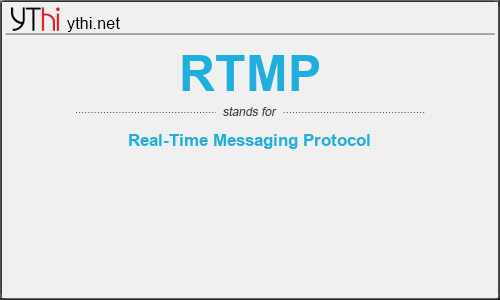What does RTMP mean? What is the full form of RTMP?
The full form of RTMP is Real-Time Messaging Protocol
Real-Time Messaging Protocol (RTMP) is a communication protocol for streaming audio, video and data over the Internet. Originally developed as a proprietary protocol by Macromedia for streaming between a Flash player and a server, Adobe (which acquired Macromedia) has released an incomplete version of the specification of the protocol for public use.
The RTMP protocol has multiple variations:
- RTMP proper, the “plain” protocol which works on top of Transmission Control Protocol (TCP) and uses port number 1935 by default.
- RTMPS, which is RTMP over a Transport Layer Security (TLS/SSL) connection.
- RTMPE, which is RTMP encrypted using Adobe’s own security mechanism. While the details of the implementation are proprietary, the mechanism uses industry standard cryptographic primitives.[1]
- RTMPT, which is encapsulated within HTTP requests to traverse firewalls. RTMPT is frequently found utilizing cleartext requests on TCP ports 80 and 443 to bypass most corporate traffic filtering. The encapsulated session may carry plain RTMP, RTMPS, or RTMPE packets within.
- RTMFP, which is RTMP over User Datagram Protocol (UDP) instead of TCP, replacing RTMP Chunk Stream. The Secure Real-Time Media Flow Protocol suite has been developed by Adobe Systems and enables end‐users to connect and communicate directly with each other (P2P).
While the primary motivation for RTMP was to be a protocol for playing Flash video, it is also used in some other applications, such as the Adobe LiveCycle Data Services ES.
The RTMP specification is a streaming protocol initially designed for the transmission of audio, video, and other data between a dedicated streaming server and the Adobe Flash Player. While once proprietary, RTMP is now an open specification.
Originally, RTMP was used to transmit content between a video player and a hosting server, which was referred to as “RTMP delivery.”
Today, its purpose is a bit different. In terms of the most modern live streaming setups, RTMP’s primary role is to deliver content from an encoder to an online video host. This RTMP function is referred to as “RTMP ingest.”
In the context of its new role in live streaming, RTMP is both important and powerful. RTMP is capable of low-latency streaming, which is a major plus for broadcasters who are streaming major events in real-time. It is also known for its minimal buffering, which truly enhances the user experience.
Aside from simply delivering files from the encoder to an online video host, RTMP technology plays a role in adaptive-bitrate streaming. It contributes to the technology that makes it possible for users to fast-forward and rewind videos. RTMP also plays a role in some web conferencing tools.
There are several variations of this protocol, which we will discuss further along in this post.
RTMP
means
Real-Time Messaging Protocol![]()
Translate Real-Time Messaging Protocol to other language.


Leave a Reply
You must be logged in to post a comment.